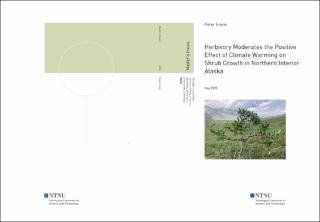| dc.description.abstract | Climate warming is a primary driver of observed increases in shrub growth and productivity across the circumpolar arctic. This proliferation of shrub biomass has altered the structure and composition of northern plant communities with cascading effects on arctic ecosystems. However, the extent to which vertebrate herbivores moderate shrubs growth responds to warming remains unclear. In this study, I used a dendroecological approach to disentangle the relative effects and interactions of climate and herbivory on the radial growth of the deciduous shrubs at Alaska’s boreal tundra ecotone. I established annual radial growth chronologies for 323 stem samples from two deciduous shrubs with markedly different growth habits and palatability, dwarf birch (Betula nana) and willow (Salix spp.). I used these chronologies to determine the growth response of each species to mean summer temperature and precipitation as well as browsing pressure from moose, snowshoe hare and ptarmigan. The results of my analysis revealed positive growth trends for both shrub species over the 28-year study period, which were sensitive to temporal variation in both climate and herbivore abundance. I found that climate, specifically summer temperature, is a strong driver of observed increases in the radial growth of both dwarf birch and willow shrubs. Furthermore, I provide evidence that spatial and temporal fluctuations in the abundance of moose, snowshoe hare and ptarmigan interact with and partially offset the positive effect of summer temperature on shrub growth. However, when the influence of herbivory is considered relative to summer temperature, I find that summer temperature is generally a stronger driver of shrub growth. Thus, I conclude that at current densities herbivores moderate but do not fully counteract the positive effects of climate warming on deciduous shrub growth in northern interior Alaska. This study illustrates that herbivores, even at low densities, can impact shrub’s growth response to climate warming, and highlights the need to consider herbivory in future efforts to model or predict vegetation state transitions at the boreal-tundra ecotone. | |
